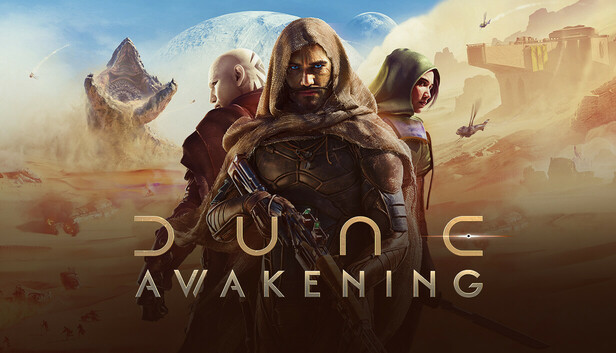Dune: Awakening – Arrakis Awaits, But is it the Oasis Gamers Hope For?
The vast, sun-scorched dunes of Arrakis have captivated imaginations for decades, and the prospect of a large-scale, interactive Dune experience has long been a fervent wish for many. Funcom, the developer behind Conan Exiles, aims to realize this dream with Dune: Awakening, an ambitious open-world survival MMO. Set against the backdrop of Frank Herbert’s iconic universe and visually inspired by Denis Villeneuve’s recent cinematic adaptations, the game promises a brutal and politically charged adventure. However, adapting such a rich and complex intellectual property into a compelling multiplayer experience is a monumental undertaking. With the PC launch slated for June 10, 2025, and early access beginning June 5, 2025 , this analysis will delve into available pre-launch information—developer insights, gameplay footage, and beta test impressions—to offer an objective and critical look at what Dune: Awakening promises and where potential challenges lie.
The game is built on Unreal Engine 5, signaling a commitment to high visual fidelity, further underscored by partnerships with NVIDIA for technologies like DLSS 4. This ambition to create a “gorgeous looking environment” that captures the cinematic feel of the recent films is a strong selling point. However, Unreal Engine 5 titles are often demanding, and early beta feedback has indeed pointed to performance concerns, with some testers noting optimization issues and FPS drops. Balancing this visual ambition with practical playability on a wide range of hardware will be a key challenge for Funcom.
Adding to the pre-launch discourse is Funcom’s deliberate shift in marketing language, moving away from the traditional “MMO” label towards “Survival Multiplayer at a Massive scale”. This change likely aims to manage player expectations, distinguishing Dune: Awakening from classic MMORPGs like World of Warcraft. The game’s server structure, which involves home servers supporting hundreds of players with up to 40 concurrently active in certain zones like Hagga Basin, and larger numbers in the shared Deep Desert , suggests an experience that might, in moment-to-moment gameplay, feel closer to large-scale survival titles rather than a single-shard world with thousands of simultaneous interactions. This distinction is crucial for players anticipating the “massively multiplayer” component.
Key Table 1: Dune: Awakening – Key Facts
| Feature | Detail |
|---|---|
| Game Title | Dune: Awakening |
| Developer/Publisher | Funcom |
| Genre | Open World Survival MMO (“Survival Multiplayer at a Massive scale” ) |
| Platforms | PC (Windows), PlayStation 5, Xbox Series X/S (console launch later ) |
| PC Release Date | June 10, 2025 (Early Access from June 5, 2025 for certain editions ) |
| Engine | Unreal Engine 5 |
| Business Model | Buy-to-Play with optional DLCs and a Season Pass (explicitly not a battle pass system ) |
A Familiar Yet Altered Arrakis: Narrative and World
Dune: Awakening carves its own path through the familiar sands of Arrakis by introducing a significant narrative divergence: an alternate timeline where Paul Atreides was never born. In this reality, Lady Jessica, obeying the Bene Gesserit, bore a daughter. This pivotal change has cascading effects: Duke Leto Atreides survived the initial Harkonnen assault on Arrakeen and is now entrenched in a bitter, ongoing war for control of the planet and its invaluable spice. This “what if” scenario provides Funcom with considerable creative latitude, allowing for new stories and player agency within the established Dune framework. Players enter this turbulent world as prisoners, sent to Arrakis with the daunting task of uncovering the mystery behind the sudden disappearance of the Fremen.
This narrative framework serves an important function for a multiplayer game. By removing the singular messianic figure of Paul, the game allows for numerous individuals—the players—to undergo their own “awakening” and rise to prominence. Instead of one chosen one, Arrakis becomes a stage for many to carve out their destinies, aligning with the game’s survival and political gameplay loops where players can rise from “a nameless survivor to becoming an agent of the Atreides or the Harkonnen”.
Developers have expressed a strong commitment to crafting an immersive Arrakis, drawing inspiration from the breadth of Frank Herbert’s novels and the distinct visual language of Denis Villeneuve’s films. The goal is to allow players to truly “experience living on Arrakis” , bridging the gap between the literary and cinematic interpretations to create a world where players can live out their Dune fantasies. The visual and thematic consistency with Villeneuve’s films is a clear draw for contemporary audiences. However, this adherence, while ensuring a certain aesthetic quality and familiarity, also presents the challenge of maintaining environmental diversity in a predominantly desert setting over potentially hundreds of hours of gameplay. Art directors on the project have acknowledged this subtlety and the efforts, such as sophisticated lighting techniques and the dynamic Coriolis storms that reshape the landscape, to combat potential visual monotony.
The Sleeper Must Awaken: Core Gameplay Mechanics
At its heart, Dune: Awakening is a game of survival against a harsh environment and even harsher opposition. This manifests through several interconnected gameplay systems designed to immerse players in the perilous reality of Arrakis.
A. Surviving the Desert Sea
The fundamental struggle on Arrakis revolves around “water discipline”. Players must meticulously manage their hydration by seeking scarce shade, crafting essential stillsuits to recycle bodily moisture, and even resorting to extracting water or blood from the planet’s fauna and fallen human foes. Unlike many survival games, there is no hunger mechanic; water is the singular, vital resource. Shelter is equally crucial, not only from the scorching sun but also from the colossal, destructive Coriolis storms that sweep across the planet.
Looming largest among Arrakis’s dangers are the iconic Sandworms. These colossal creatures are attracted to rhythmic vibrations on the sand, posing a constant, lethal threat. An encounter resulting in death by sandworm is particularly punitive, leading to the permanent loss of all items the player was carrying at the time. This hardcore survival mechanic, while deeply thematic and intended to create genuine tension , may prove divisive. While some players will appreciate the high-stakes thrill, others, particularly those accustomed to the more forgiving death penalties common in MMOs, might find it overly frustrating. The balance between this thematic severity and fair counter-play or risk mitigation strategies will be critical for player retention. It’s worth noting that other forms of death seem to result in resource loss but not necessarily gear loss, suggesting a nuanced approach to death penalties overall.
B. Charting the Shifting Sands
Exploration is a key pillar of Dune: Awakening, facilitated by iconic Dune technology. Players will traverse the vast landscapes using ornithopters for aerial travel, suspensor belts for enhanced ground mobility, and rugged sandbikes for swift passage across the dunes. Traversal is further enhanced by mechanics like free-climbing and the Shigawire Claw, a grappling hook device.
Central to the exploration loop is the “Deep Desert,” a high-risk, high-reward region that is primarily player-versus-player (PvP) focused. This zone is not static; it is dramatically reshaped on a weekly basis by the aforementioned Coriolis storms. These storms alter the terrain, uncovering new resource deposits, hidden locations like ancient shipwrecks and abandoned Imperial testing stations, and valuable secrets, fostering what Funcom describes as an “infinite exploration” loop. This dynamic map reset is a significant attempt to address the common MMO problem of static endgame zones and resource depletion. If implemented successfully, it could create a recurring “Coriolis race” as players and guilds vie to be the first to discover and exploit the newly revealed opportunities, driving sustained engagement. However, the technical challenge of seamlessly and meaningfully reshaping large, populated PvPvE zones on a weekly basis is considerable.
Beyond the dangers of the deep desert, players can find respite and social interaction in hubs like Arrakeen and Harko Village.
C. Building Your Legacy
Drawing on their experience with Conan Exiles , Funcom is implementing a robust base-building system in Dune: Awakening. Players can construct anything from rudimentary shelters to formidable fortresses , serving as vital hubs for protection, crafting, and resource storage and refinement. A unique aspect is the ability to align with one of the Great Houses, such as Atreides or Harkonnen, which grants access to their distinct architectural styles, visually inspired by Villeneuve’s films. This not only enhances role-playing opportunities but also provides visual differentiation for player-built structures. Due to the ever-present threat of sandworms, building directly on open sand is ill-advised; players are encouraged to construct their bases on more stable “rock islands”.
A particularly innovative feature is the Blueprint system. This allows players to save their entire base designs as blueprints, which can then be shared with allies or, significantly, sold to other players on a server-wide Exchange. This has the potential to create a unique player-driven economy centered around architectural design, empowering creative builders and fostering a new form of trade. Talented architects could become renowned for their designs, selling them to players who excel in other areas but lack building prowess. This promotes specialization and interdependence, hallmarks of a thriving MMO economy, and allows for rapid deployment of pre-designed bases, which could be invaluable in dangerous territories like the Deep Desert. Furthermore, “Solido Projections” aim to simplify cooperative building efforts.
The Dance of Power: Combat, Economy, and Politics
Beyond mere survival, Dune: Awakening aims to immerse players in the intricate power struggles that define Herbert’s universe, through its combat, economic, and political systems.
A. The Slow Blade and Beyond
Funcom has stated its goal for Dune: Awakening‘s combat to be a “new benchmark for combat in open world survival crafting games” , clarifying that while it’s more elaborate than typical survival game fare, it’s not aiming for the hyper-responsive action of titles like Doom or Elden Ring. Authenticity to the Dune IP is paramount, with iconic elements like Holtzman shields playing a central role. These personal energy fields deflect fast-moving projectiles but are vulnerable to slower attacks, encapsulating the famous adage, “the slow blade penetrates the shield”. Players will wield dart guns, crysknives, and engage in a variety of combat styles including ranged, melee, utilizing special abilities, leveraging spice-induced prescience, deploying gadgets, and even vehicular combat.
Players begin by choosing an archetype—Trooper, Bene Gesserit, Mentat, or Swordmaster, with a Planetologist archetype unlockable later. Each offers unique abilities and progression paths, with the eventual option to mix and match skills from different schools. Traversal abilities, such as grappling hooks and dashes, can also be integrated into combat.
However, beta feedback has been mixed regarding combat. While some appreciate the tactical potential , many testers found it, particularly melee, to be clunky, unrefined, or underwhelming. Issues cited include unresponsive controls, problematic enemy AI, exploits like inescapable stun-locks, and a general lack of impact. The limited number of active skill slots (three active, three passive ) forces players to make difficult choices between combat utility and essential traversal or survival skills, a design decision that has drawn comment. This mixed reception for a core system poses a risk to the game’s ambitious PvP and political endgame. If combat isn’t satisfying, fair, or technically sound, player engagement in the conflict-driven Deep Desert and Landsraad systems could suffer significantly.
B. He Who Controls the Spice
Spice Melange is, unequivocally, the most valuable resource in the Dune universe, and Dune: Awakening places it at the nexus of its gameplay systems. It is essential for crafting high-tier equipment and items , for personal enhancement by unlocking potent new abilities and even limited spice-induced prescience , and as a crucial currency in political maneuvering – used for bribes, gaining favor with factions, and influencing decisions within the Landsraad council.
The acquisition of spice is a primary driver of activity and conflict. Players can harvest it from naturally occurring spice blows, deploy large-scale industrial harvesters (which invariably attract sandworms), engage in raids on rival operations, trade for it on the open market, or earn it through quests. However, the consumption of spice is not without peril; it carries the risk of addiction and potentially even death, creating a delicate balancing act for players. This “spice economy” is intended to be a dynamic and central feature. The multifaceted nature of spice, deeply integrated into crafting, character power, and political systems, creates a complex web of incentives. This could lead to fascinating emergent player behaviors and a truly dynamic economy. However, it also introduces the risk of significant power imbalances if access to spice becomes overly concentrated in the hands of a few dominant groups, or if its various uses and acquisition methods are not carefully balanced.
C. The Great Game on Arrakis
Dune: Awakening is described as a “multiplayer survival game on a massive scale” , where players can align themselves with powerful entities like House Atreides or House Harkonnen. The previously mentioned Deep Desert serves as the primary arena for large-scale PvP, where hundreds of players representing various guilds can clash over control of precious spice fields and strategic control points.
Social interaction and trade are facilitated in designated social hubs such as Arrakeen and Harko Village. Beyond direct conflict, the game promises server-wide politics and intrigue, most notably through “The Landsraad,” an advanced gameplay mechanic presented as a council system where players can influence server-wide policies, potentially related to spice distribution or factional standing. Guilds will be able to pursue cooperative objectives and engage in large-scale conflicts, including the ominous “War of Assassins”.
Funcom’s decision to not offer private servers at launch , while understandable from the perspective of maintaining a controlled MMO environment and mitigating cheating, might alienate a segment of the survival game audience. Many players in this genre prefer curated experiences with friends or specific rulesets, often facilitated by private servers (as seen with Conan Exiles ). While Funcom is exploring the possibility of rentable “private instances of Hagga Basin” , the absence of dedicated server software means players seeking full control or a smaller, more intimate group experience will not have that option initially. This could be a barrier to entry for some who are wary of the typical dynamics of public MMO servers.
Whispers from the Beta: Early Impressions and Critical Reception
Early access through closed beta programs and hands-on previews has provided valuable, if sometimes conflicting, insights into Dune: Awakening‘s current state.
Testers have widely praised the game’s strong sense of immersion and atmosphere, lauding its faithfulness to the Dune lore and the aesthetic established by Villeneuve’s films. The world design, particularly the terrifying impact of sandworms and the dynamic nature of Coriolis storms, has often been highlighted as a major strength. Core survival mechanics, such as water discipline and the unique ability to harvest blood for hydration, are generally seen as fitting and engaging. The base-building system, enhanced by faction-specific architectural styles and the innovative blueprint system, has also received positive feedback. The narrative premise of an alternate timeline has piqued the interest of many, offering a fresh take on familiar Dune themes. This strong IP integration is arguably the game’s most compelling unique selling proposition and will likely be the primary magnet for a large portion of its initial player base. However, this deep investment from fans also means that significant flaws in execution could be perceived as more damaging than in a generic title.
Conversely, criticisms have consistently emerged around several key areas. The combat system, especially melee, is frequently described as clunky, unrefined, or simply not engaging enough, with testers pointing to poor enemy AI, problematic stun-locking mechanics, and unsatisfying gunplay. Some players found the early game progression slow or the content variety within the beta slice to be lacking, encountering repetitive enemy types or uninspired location designs. Technical performance, including FPS drops and server lag (particularly during PvP encounters), was a notable concern for a number of participants. Questions also remain about the long-term depth of the MMO features and how seamlessly they will integrate with the core survival gameplay loop. Minor issues like awkward UI elements or unintuitive mechanics were also reported.
Interestingly, feedback on the “grind” aspect has been somewhat divergent. Some testers found the resource grind to be minimal compared to other survival titles, allowing more time for active gameplay. This might suggest a deliberate design choice by Funcom to streamline early survival phases, potentially to accelerate players into mid-game systems like factional politics and Deep Desert exploration. This could appeal to an MMO audience less tolerant of extensive early-game resource gathering but might disappoint survival purists who enjoy that particular loop.
Funcom has shown responsiveness to player feedback, for instance, by expanding access to a beta weekend to all pre-order customers following initial community complaints. The company has also committed to further communication and showcases detailing mid-to-endgame content not available in early beta tests , and is publicly acknowledging the need for ongoing performance optimization.
Key Table 2: Early Impressions – Pros & Cons Summary
| Aspect | Potential Pros (based on previews/beta) | Potential Cons (based on previews/beta) |
|---|---|---|
| World & Narrative | Deeply immersive Arrakis, faithful to Dune lore ; Intriguing alternate-timeline narrative. | Concerns about long-term environmental variety in a desert setting, despite efforts. |
| Survival Mechanics | Unique and thematic (water discipline, sandworms, Coriolis storms) ; Dynamic world events (Coriolis Storms creating “infinite exploration” ). | Punitive death mechanics (sandworm item loss ) might deter some players. |
| Building & Crafting | Robust and creative base building with faction styles & blueprints. | Some finicky placement reported in beta. |
| Combat | Thematic elements like shields and “slow blade” ; Potential for tactical depth with archetypes and abilities. | System, especially melee, widely reported as clunky, unbalanced, or unengaging ; Repetitive early-game AI in beta. |
| MMO & Social Features | Ambitious political systems (Landsraad ); Large-scale PvP in Deep Desert. | Concerns about long-term MMO depth and meaningful progression loops ; Questions about server population balance and impact of “mega-guilds”. |
| Technical Aspects & User Experience | Visually impressive on high-end systems. | Technical performance issues (FPS, server lag) reported ; Some UI/mechanics found unintuitive or poorly explained. |
The Golden Path or a Desert Mirage?: Potential and Pitfalls
Funcom is no stranger to the survival MMO genre, with Conan Exiles serving as its most prominent predecessor. This experience provides a foundation in building systems, managing live service games, and iterating based on player feedback. Lessons learned from Conan Exiles regarding server performance, the intricacies of player-driven economies, and the challenges of balancing PvP and PvE elements will be invaluable. Funcom has a history of long-term support for its titles, with Conan Exiles still receiving updates eight years post-launch , suggesting a similar commitment to Dune: Awakening.
The game’s most innovative features—the alternate timeline offering narrative flexibility, the dynamic Deep Desert constantly reshaped by Coriolis storms, the deeply integrated multifaceted Spice economy, and the ambitious political machinations of the Landsraad system—are genuinely exciting and hold the potential to set Dune: Awakening apart.
However, significant pitfalls remain. A primary concern is achieving a satisfying and sustainable balance between the deep, often harsh, survival mechanics and the engaging, long-term progression loops expected of an MMO. The complex Spice economy, while thematically rich, must be carefully managed to prevent runaway power accumulation by dominant player groups, which could stifle competition and alienate smaller guilds or solo players. Delivering compelling and varied endgame content beyond the initial novelty of exploration and factional skirmishes will be crucial for long-term player retention. Furthermore, the technical polish and server stability at launch are paramount, especially given the choice of Unreal Engine 5 and the game’s ambitious scale. Early beta reports of performance issues and combat clunkiness highlight areas requiring significant attention.
The game’s business model is buy-to-play, with plans for future optional paid DLCs and a “Season Pass” bundling several of these DLCs—explicitly not a recurring battle pass. This model is generally well-received by players wary of subscriptions or aggressive microtransactions. However, the announcement of a Season Pass for multiple DLCs before the base game has even launched has drawn some skepticism from players concerned about content being sectioned off too early.
The success of Dune: Awakening‘s ambitious social and political systems, like the Landsraad and large-scale faction warfare , will heavily depend on Funcom’s ability to cultivate a healthy server community. This requires robust tools for player governance that are both engaging and resistant to exploitation or stagnation by dominant guilds—a notoriously difficult challenge in MMO design. The interconnectedness of servers within a “World” and the shared Deep Desert add further layers of complexity to this social engineering puzzle.
Moreover, while Funcom emphasizes that Dune: Awakening will have a “full launch” and is not an Early Access title , the inherent nature of survival MMOs and Funcom’s own history with Conan Exiles suggest that the game will, in practice, be a live service. It will likely evolve significantly post-launch through patches, free updates, and paid DLCs. Managing player perception of the launch state versus its long-term potential will be critical to avoid disappointment if the game launches with rough edges, a common occurrence for games of this scale and complexity.
Finally, the game’s hybrid approach to PvP—largely confining it to the Deep Desert and specific pockets within the more PvE-focused Hagga Basin , and notably excluding traditional base raiding in PvE areas —attempts to cater to a broad audience. This could widen its appeal but also risks not fully satisfying either PvE-focused survival players or dedicated PvP enthusiasts if one aspect feels underdeveloped or if the balance between the two isn’t carefully struck.
Conclusion: Will You Answer the Call of Arrakis?
Dune: Awakening presents a compelling vision: a chance to forge a destiny on a vast, treacherous, and politically charged Arrakis. It aims to blend the desperate struggles of survival with the grand scope of multiplayer conflict, exploration, and empire-building, all steeped in the rich, evocative lore of Frank Herbert’s universe. The ambition is undeniable, and many elements showcased—from the stunning recreation of Arrakis and the unique Dune-centric survival mechanics to the innovative concepts of a dynamically shifting endgame zone and player-driven architectural economy—exhibit considerable promise.
However, the journey from ambitious vision to polished reality is fraught with challenges. The execution of core gameplay systems, particularly combat, requires significant refinement based on early feedback. Ensuring technical stability and performance across a wide range of PC hardware for such a visually detailed Unreal Engine 5 title is a monumental task. The long-term engagement will hinge on Funcom’s ability to deliver on its endgame promises for the Deep Desert and the Landsraad, fostering a vibrant, dynamic, and reasonably balanced player-driven world.
The ultimate success of Dune: Awakening may well lie in its capacity to facilitate truly emergent narratives and player-driven sagas—the holy grail for any sandbox MMO. The confluence of survival pressures, fierce economic competition for Spice, intricate political maneuvering, and large-scale factional conflict within a constantly changing world provides all the necessary ingredients for such unscripted drama.
Funcom is navigating a delicate path, attempting to cater simultaneously to hardcore Dune lore aficionados, seasoned survival game veterans, and the broader MMO player base. Satisfying all three demographics with every design choice is an almost impossible feat. Inevitably, compromises will be made that may not resonate with everyone. Yet, if the core vision is strong and the execution sound, Dune: Awakening could carve out a unique and enduring niche in the crowded online gaming landscape. It will likely appeal most to players who relish a challenging survival experience deeply interwoven with grander political and economic struggles, and who are prepared for the evolutionary, live-service nature of modern online worlds.
The sands of Arrakis are stirring. When Dune: Awakening launches on June 10th, will you be among those seeking to master desert power? What are your hopes and fears for the game? Share your thoughts in the comments below.












Add comment